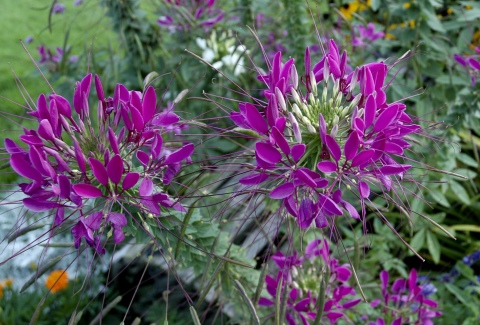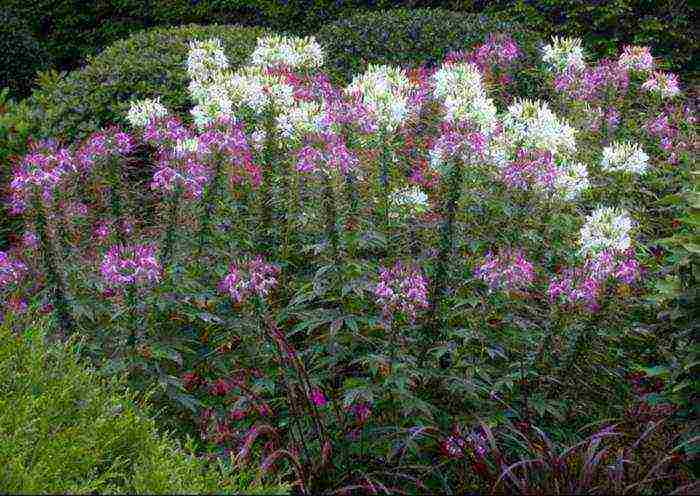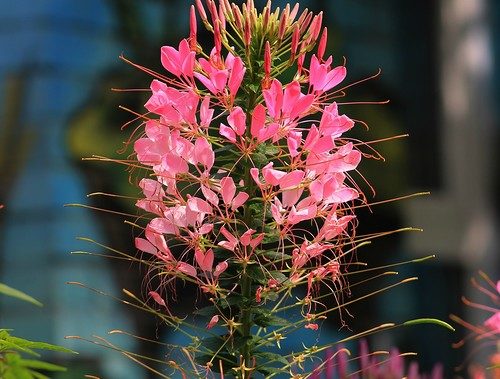Cleoma - growing in the garden in the open field
Cleome care is simple - you need to maintain moderate soil moisture, apply fertilizers and make sure that diseases do not affect it. In addition, you need to weed the soil around the cleoma in a timely manner or immediately mulch to save yourself the hassle of removing weeds and loosening the soil.
Watering and feeding cleoma in the open field
In order for the cloe to bloom profusely and not get sick, you need to remember an important thing - the flower is afraid of overflow. Therefore, it is better not to add a little to the plant than to cause rotting of the roots as a result of frequent and abundant watering.
The amount of dressings depends primarily on the composition of the soil and the nature of the cleoma development. If the soil is fertile, light and the plant grows well, fertilizer can be applied every two to three weeks. If you notice poor cleoma growth, insufficient budding, it is advisable to spray the aerial part of the plant with an aqueous solution of mineral fertilizers. In both cases, a Fertika fertilizer solution is suitable (for 5 liters of water, 2 tablespoons of the product). To stimulate the growth of buds, a solution of "Zircon" is suitable.
Diseases and pests
Since cleoma flowers have a scent that is not quite usual for flowers, pests try to bypass it. She can get sick with the wrong irrigation regime or when planting in an area with a high groundwater table. If you choose a planting site and care for the plant correctly, then it will not hurt at all.
Growing features
In order for the seedlings to be healthy and resistant to diseases, the preparation of the soil and seed material should be done at the end of February. First of all, you need to know how cleoma is grown from seeds, when to plant this plant.
Soil preparation and landing sites
Seeds are planted in planting containers or peat pots with loose nutrient soil. The substrate can be bought at the store or prepared with equal shares of humus, sand and turf. Seed material before planting is soaked in special formulations for protection and faster germination. The distribution over the surface must be uniform. Sprinkle them on top with a small layer of soil.
Important! To prevent seedlings from drying out, you need to remove the film from the containers for ventilation and moisten the soil as necessary. Under favorable conditions, cleoma seedlings will hatch within 10-14 days after planting.
Next, the containers are placed in a lighted place. If this is not the case, additional lighting is done.
Under favorable conditions, cleoma seedlings will hatch within 10-14 days after planting. Next, the containers are placed in a lighted place. If this is not the case, additional lighting is done.

Growing seedlings
The nuances of growing seedlings
For the normal development of the shoots, they need to be watered regularly so that the soil is moist. Another rule that must be observed in order to grow glue is watering young seedlings with a weak solution of potassium permanganate. It will kill spores of fungi and viruses and protect plantings.
After the appearance of the second pair of true leaves, a pick of plants occurs. They do it carefully. After a couple of weeks, the flowers are fed with complex mineral fertilizers.
You should know! So that the sprouts develop evenly and do not stretch out, the containers are regularly rotated relative to the sun.
A cleoma plant is planted in open ground when the threat of frost has passed. It is pre-hardened. You can sow seeds directly into the ground in late May or late autumn.The depth of the grooves in this case is 15 mm, and the distance between the rows is 35 mm.
Sowing seeds in the garden
The instruction for planting seeds in open ground in spring is as follows:
- Soak in a stimulating preparation (zircon, epin and others).
- Dig up the site, make a bed and grooves in it. The depth of the ditch is about two millimeters. The distance between them is 25-30 cm.
- Spread the seeds evenly over the surface and sprinkle with a layer of soil. Put covering material on top.
- After emergence, it is harvested.
- When the first leaves appear on the plants, they need to be thinned out, leaving them at a distance of 50-70 cm from each other.
Outdoor cultivation
Cultivation of cleoma can be carried out in any soil, the main thing is that the plant receives the required amount of fertilizers from additional dressings. For planting, you need to choose a bright and wind-protected place.
Planting seedlings flower splashing champagne

Young plants are planted in small holes. It is necessary to leave a distance of at least 50 centimeters between the plants. Bushes planted at such a distance will produce lush and powerful plants. This distance will help ease the care of the bushes and reduce the likelihood of disease and pest damage.
The soil around the seedlings is compacted and shed, this is an important condition.
Champagne splash flower care
Outdoor plant care:
- Watering. Watering is recommended with warm, settled water. Rainwater can be used. It is better to leave this plant without water than to water it too often. Cleoma simply will not tolerate stagnation of moisture.
- Fertilizer. 2 weeks after planting seedlings in open ground, it is fertilized with complex compounds. For fertilization, you can use complex formulations for garden plants. Re-feeding should be done before budding begins. A diseased or weakened plant should be sprayed with a weaker concentration of fertilizer.
- Loosening. The ideal option would be to loosen after each watering. In the process of moistening, the soil becomes dense and too heavy, air does not flow to the roots. Loosening makes the soil light and air flows correctly to the roots. Such a plant grows much faster and develops better.
- Weed removal. Weeds especially need to be removed around young plants. Fast-growing weeds will simply fill the surface of the earth and destroy the shoots.
Features of cleoma care
Cleoma is light and heat-loving, drought-resistant, does not tolerate stagnant moisture. Prefers a sunny location, with neutral well-drained substrates. It is unpretentious to soil fertility; on poor soils, the plant is fed only once at the beginning of the season. Water only in hot and dry periods.
Watering
Cleoma belongs to drought-resistant plants, therefore we adhere to the standard: less is more, but better. We water rarely, but abundantly and only in severely arid summers.
After drying, the soil is loosened, at the same time removing weeds. A layer of mulch that prevents the soil from drying out quickly can help reduce labor costs.
Top dressing
The soil for cleoma should be fertilized before the planting operation with a small amount of organic and mineral fertilizers. Then the top dressing is added every 14 days using complex fertilizers such as Fertika Lux in the ratio of 2 tablespoons to 10 liters of water.
Close attention must be paid to weakened cleoma bushes, which need to be sprayed with a liquid that consists of a teaspoon of fertilizer dissolved in three liters of water
Pruning
The bushes are quite unstable, they need to be maintained, otherwise they can decay from the wind. For this purpose, pegs are nailed in the corners of the flower bed and the fishing line is stretched. After the flower stalks wither and the pods develop, they must be cut off so that self-sowing does not occur. Only those inflorescences that bloom first are preserved.
Seed collection
Since the plant reproduces only by seed, for future planting it is necessary to collect seed in the fall. In order to determine the degree of maturity of seeds, it is enough to look at them: ripe specimens have a diameter of about one and a half millimeters, the shade of their yellow-brown depends on the color of the plant used.
If you skip harvest time, the seeds can fall to the ground, spilling out of the box. In order to prevent this from happening, competent gardeners recommend that you put light bags of fabric on the boxes in advance, which will not let the seeds get lost.
Diseases and pests
Due to its juicy, persistent, far from floral, smell, pests not only do not settle on the plant, they avoid it. By planting a plant in different parts of the flower bed, you can save all your “pets” from unwanted guests. It is exposed to diseases only in conditions of excessive moisture.
If you suspect the onset of the disease, or the development of pests, they are immediately treated with specific preparations called fungicides. Cleoma is an extremely interesting flower that does not require difficult growing conditions. Thanks to breeding through seedlings, flowering can be obtained much earlier than other breeding methods.
Cleoma after flowering
Questions about how to care for a plant, how cleoma blooms were discussed. What to do after this period ends? Collect seed pods and prepare the plant for the winter period.

Seed capsule
For your information! It is important to collect the seed pods in a timely manner. Although they do not affect the growth and development of the plant, they can open up, crumble
Seed collection
The seeds are stored inside the fruit pods. If they are properly collected, stored, then they can be planted next year in open ground or for seedlings.
You can understand that the seeds are ripe by their color: they turn yellow or yellow-brown. In addition, it is advisable not to allow them to spill during collection, since they can remain in the soil throughout the winter and sprout up on their own in the spring.
Wintering
Usually the plant is dug up in late autumn, and a new one is planted in the spring. Cleoma does not tolerate frost well, because she is used to warm, hot climate. Even warming with a film and special materials will not save the plant from death, since the soil, and with it the root system, freezes very much.









































